Text
summary

This module - this semester as a whole - has been very turbulent indeed. It ended in a way nobody could have predicted at the start. The pandemic has put a dampener on many things, one of them my studies; although the way we are submitting this blog has made it easier on us. It’s given me things to work around and find alternatives for, and despite how annoying that may feel at the time, I’m glad to have been able to take initiative and do it that way.
The goal of Professional Practice is to step back and take a look at my work and how I work, to review it and see what I want from it, and to look at others and their processes to help me to do so.
On the whole I find it difficult to talk about my practice, mainly because I’m not sure I’ve ever really had one so cut and dry. I still work in the same way I always have: mainly for school, and just doing the odd sketchbook work when I want to or can find the time. I’ve always thought of my career as something far-off and in the distance, something to worry about later after I graduate and have no other choice but to worry about it. I’ve been preoccupied with projects at school and university and then when I am on holiday or have spare time, I feel very drained and sometimes kind of bored of doing creative work, so I occupy myself doing other things. I think changing my mindset surrounding creativity and creative work will help me going forward.
So, this module has forced me to think about the career I’m going to have eventually. I’ve always thought that after I graduate, I will get an apprenticeship or internship in a studio of sorts. My plan has been, for years, to work in film or tv, doing concept art or character design, and I have researched in the past the different ways into a career like this. However, I’ve never had a cut and dry plan, specific steps to follow. I think for me, setting my life out like that gives me a bit of anxiety, because it’s very easy for life to take several different turns along the way.

My immediate action plan for the next few weeks is to start getting myself out there. With time to engage with other creatives and time to work on projects of my own, I want to promote myself as an illustrator and improve my engagement on various social media. I would love to start posting art-related content on YouTube (above) and start building a community I can engage with. Although it’s not exactly building a business, it’s certainly the first steps toward one.
I feel I have learnt things about the working world from this module that I will certainly take away with me. What surprised me the most about the people I spoke to or listened to talks from is how they still prioritise creativity and imaginativeness above everything, even after so many years. I’ve said many times in this blog that I don't always feel particularly creative or imaginative, as art has turned from a hobby into my education and ideally one day, my career. I think, however, this is an age-old question that most artists struggle with, even professional ones, and I will have to take this in my stride as I grow and evolve as an illustrator.
0 notes
Text
platform for joy
What is happiness?
It can be defined in a variety of ways but we defined two; the first of which is that of a transient emotion, one that comes and goes due to successes and failures, or experiences. The second is the idea of a ‘happy life’, flourishing over time.
Aristotle defined ‘Eudaemonia’, a class of happiness that comes from a life of virtue and meaning, as opposed to pleasure. His theory is that eudaemonia should be our ultimate aim, and that pleasure and happiness are not the same.
When listing things that make us happy, we have a tendency to list material needs before others. There is proof that once we have achieved financial stability, money actually causes us increasingly less happiness: in fact, the more money we earn, the unhappier we get. Others may refer to an easy life, one with no challenges, but there’s no proof that this causes happiness either. Challenges enrich us and give us new experiences, ones we don’t earn if we never push ourselves above our limits. There are many surprising factors that we might think are great for us but aren't: plenty of choice (too much can cause decision fatigue, leaving us with no ability to make choices), efficiency (for example, ATMs instead of bank lines, leaving us with less human interaction) and hedonism (the pursuit of pleasure can actually lead to feelings of emptiness and lack of meaning).
The things that actually lead to happiness are far more simple. Examples of this include having shelter, good health and positive interactions with others. Another example is overcoming challenges which leads to an intrinsic feeling of reward, as opposed to receiving rewards from others. External rewards like grades might cause short-term happiness but the effect rarely lasts long.
Social connection is incredibly important in the pursuit of happiness. Epley and Schroeder (2014) found that passengers who interacted with other passengers, on a morning rush hour train, improved their wellbeing and the wellbeing of those they spoke to. Loneliness is proven to decrease cognitive function, mood and even immunity; people who are lonely are more likely to catch the common cold, for example.
In addition, our physical environment also affects happiness - where do we feel good? Often, it is by the sea, outdoors, away from civilisation. It’s proven that cities drain us: city dwellers suffer anxiety and psychological disorders at a much higher rate. Urban pollution affects our health and, in turn, our wellbeing. Plus, having discussed how more money can make us less happy, it’s often the case that people move to bigger cities for better jobs with better pay. Being away from this environment is proven to be better for us, both physically and psychologically. We are much happier around people we love, doing things we enjoy - especially in places we can work on and better ourselves.

The Pyreneès, August 2018
Physical environment also ties in to physical needs. As people, we need specific things to thrive: good diet, proper hydration, exercise, enough sunlight and at least eight to eight and a half hours of sleep. It’s very common that most of us don't do many of these; in fact, we have become used to being tired or having a poor diet and instead normalise it. As a society, being exhausted is very normalised, and we often use it to mean we’ve worked harder or achieved more, but this has a very negative effect on our happiness. Exercise not only makes us physically healthier but also psychologically; it offers both external and internal rewards. It’s been proven that we need at least half an hour of sunlight every day, even if it’s not direct, boiling hot sunlight - just being outdoors when it’s daylight is enough, especially on our faces and arms. Even sitting indoors with the curtains open instead of the artificial lights on can have an effect.
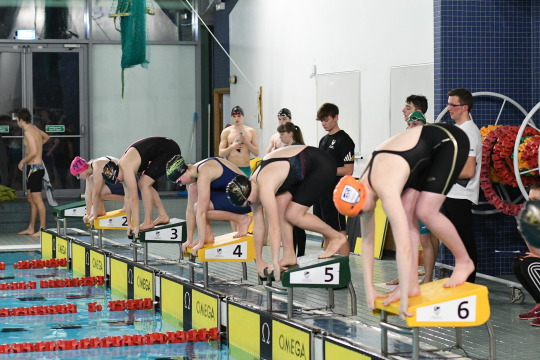
Exercise! March 2019
I found this lecture very interesting indeed. It confirmed a lot I already suspected, but it was great to hear Gareth’s thoughts on each matter. It also reinforced for me things I was letting slip; my eight hours of sleep a night, as well as the fact that I stand on the train platform with my headphones on and avoid interacting with strangers.
Research
As soon as we came out of the lecture and exchanged details, I set up a Google Doc to keep track of any research I came across and shared it with my group. The document can be found here! I compiled research on the importance of human interaction, research on happiness itself and how to be happier, and eventually once we’d come up with some ideas I did some research on the type of project we were considering. There are links to articles and YouTube videos that I found helpful and interesting, or took inspiration from. The ideas that we did come up with are also listed on the doc.
Although it was a document I shared with the group I was the only one to contribute to it until very late, so all but one piece is my personal research.

Our group, in our last meet up before lockdown!
Group Work
Before the university shut, and when we were still working as a group, we met up a few times and made as much progress as possible with the mind map. For our early meetings not everyone was present, but we each made contributions over time. We tried to include as much research as possible but we didn't manage to complete it entirely, and as we went into lockdown after one of our meetings it is still locked away in our university studio!

Unfortunately this picture was an early one, and we never got a chance to take a picture of it as we left it. Because of the lack of progress in the picture above I decided to complete a mind map of my own at home. The one below is my personal one. One of the pieces of research - the one in the top right concerning the psychology of colour - was Chloe’s research, shared in the group Google Doc, but the rest was my own.

The Pitches
We came up with a couple of ideas to pitch to our peers before we converted to working individually. Of course, this didn't end up happening, but we decided to all use the ideas on our own blogs, as we came up with them together in our meetings.

The first idea involved games, and partaking in a game with a stranger on the train platform. Lots of my research places huge importance on social interaction, especially with strangers. Epley and Schroeder’s famous study is named ‘The surprising benefits of talking to strangers’, and details how people that interacted with strangers in the morning found it had a positive effect on the rest of their day. We tried to incorporate this concept into our research.
We had a couple of doubts about it, however, that steered us away from this concept. First of all, perhaps people that are more introverted and shy wouldn’t take part in this idea. From personal experience, commuting to university multiple times a week, I know that most people on train platforms in the morning barely look at one another, let alone play a game with them. This was a factor in Epley and Schroeder’s research, as they said even introverts found there were positive benefits in talking to strangers. However, it’s entirely possible this introversion would mean people shy away from taking part.
Another thing that we discussed re: this idea was that we weren't sure that competitiveness should play a part in it. Many people are competitive and receive joy from winning and/or taking part in a game, but others aren't, and would avoid competition. We also weren’t sure whether losing a game would cause positive social interaction, as even though the people playing have interacted, the fact one lost may not cause the positive benefits described in Epley and Schroeder's research.
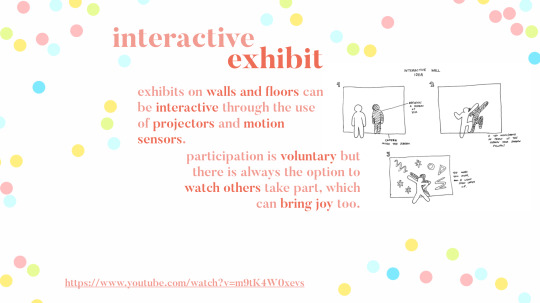
This second idea began from one of Kim’s suggestions and grew from there. He proposed a kind of interactive fountain that recognised movement, and your body movements changed the colours projected onto or lighting up the water. I tried to research into something similar, and although there was nothing quite like it, I found YouTube videos of other interactive sculptures and installations.
I also really love this one by FLUIDIC called Sculpture in Motion, a temporary exhibit for the New Design Museum in Milan. Although there’s a kind of magic captured in this exhibit, the real benefits come from its size and the lights in a dark room. I think this would be difficult to capture on a platform.
This one called River of Grass: Virtual Reality by Formula D Interactive is a tunnel exhibit mimicking the Everglades and its wildlife, using cameras and projectors to do so. I preferred this idea because it’s easy to personalise and is informative as well as interactive.
There are quite a few benefits to this idea. As a group, we liked how it could be individual. It combines a few of the aesthetics of joy: play, for sure, and others like surprise, harmony, energy and transcendence. Something unusual at the beginning of the day can surprise you into being happy for the rest of it.
The Project
The River of Grass: Virtual Reality exhibit is based around the wildlife in the Everglades in Florida. I thought this would be easy to emulate in an exhibit of my own in Derbyshire, seeing as Derbyshire and the Peak District is well-known for its wildlife. Below is a list of iconic Derbyshire wildlife, all of which were visually appealing and I hoped I could include in the project. I found and listed these from the Derbyshire Wildlife Trust’s Wildlife Explorer, which will be relevant later!

The Everglades exhibit is aimed at children, but most of the people on a platform in the week are much older, usually adults commuting to work and students commuting to various places of education. I didn’t want the exhibit to be too childish, so using a more mature and illustrative art style helps this.
In our happiness talk, it was said that one of the big factors affecting our happiness is our physical environment. Access to nature and the great outdoors has a huge impact on our mental health and physical wellbeing, and tying this into my project could have an impact too. Being inside but having a projection that brings the outside to you could bring joy and improve the mental health of those walking through it in the station.
Derby Midland Station, like many train stations, has a long tunnel-like passage connecting the platforms together. This is the perfect area for an exhibit like this one, as it creates an enclosed space, where it’s possible to project images onto the walls and floor and create an immersive experience.

I have illustrated some of the animals included in the exhibit, as it’s not possible to see them up-close on the above picture. The idea is that they are visible on the projections, and some are easy to catch in passing (like the Chinese water deer) whereas others take more attention (such as the Hazel dormouse). This makes the exhibit not only something to look about, but also something that takes time to search through. It lends itself well to stations as many people, such as commuters, have little time to stand and search through the exhibit so will catch the larger, more obvious animals. Other passengers that have more time on their hands, ones waiting around for trains, can lend more time to looking.
Ideally, the projection would use sensors to add interactive elements to the exhibit, such as the grass moving as you walk through it, or a bird flies away or a mouse hides if you put your hand near it. This makes it a more active exhibit that creates entertainment through involvement, not just through aesthetics.
If I were an animator, or we were still working in a group and I had an animator working alongside me, I would include gifs as an example of how the animals might move. Unfortunately, if I tried to include them here, this blog would be uploaded in a year or so - my animation skills are not quite up to scratch!

Hazel dormouse (from the Woodland Trust).

Chinese water deer (from Encyclopaedia Britannica).

Great Spotted Woodpecker (from GardenBird).
So the exhibit is not just something to look at, I thought it would be useful to also make it a learning experience. Each animal on the projection is projected alongside a QR code, and a scan of the QR code sends the person scanning to a web page. I thought that it would be great to have the exhibit as a sort of collaboration between Derby Midland Station and the Derbyshire Wildlife Trust, who have lots of information available on their website.
Learning has a big impact on our happiness. We are happier when challenging ourselves internally and learning new things. Making it quick and easy to learn something new, even if it’s as you walk through the station on your morning commute, can promote mental stimulation and therefore happiness and joy.
Including this QR code and link not only provides a learning element to the project but can also link in very useful conservation projects. Sending viewers to the Wildlife Trust page, one that relates to the animal they see before them, could aid in raising awareness for vulnerable species.
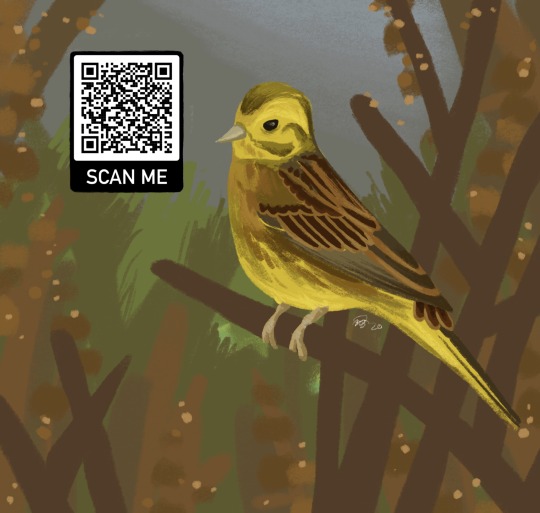
Yellowhammer (from Derbyshire Wildlife Trust).
Above is an example of the QR code concept (scan the code!) using the Yellowhammer.
On the Birds of Conservation Concern 4 (BoCC4) list by the British Trust for Ornithology, the Yellowhammer is included in the red section. Any bird on the red list is increasingly at risk and has shown massive declines in breeding populations. Most Derbyshire Wildlife Trust pages include the conservation status of the page’s subject, and further down has a section on “How people can help”, often with suggestions to join your local wildlife trust. Although many of these pages aren't fully complete with information on how to help from home, a possible partnership with the Derbyshire Wildlife Trust could encourage them to update the specific pages included in the exhibit with further information.
At the very least, including endangered or at risk animals and insects alongside more common, well-known Derbyshire wildlife would raise awareness for conservation efforts and give people access to more information about them.
Although not included in our happiness talk, those that volunteer or give to charity are happier (Patrick Svedin, Utah State University). If you give to charity through your own free will it contributes more to your lasting happiness than if you treat yourself with the same money, which provides momentary happiness that doesn't last as long. Learning more about the animals included in the exhibit means those that read the webpages have the knowledge to help local wildlife and, if they want to, the opportunity to donate to or become a member of the Derbyshire Wildlife Trust.

So...
Platform for Joy was a weird project for me - and I think probably for many others too. I started off with a group, expecting a project carried out among multiple people, with a shared workload and shared ideas.
The change to individual instead of group work was quite smooth as I had completed most of the research I used by myself already. There are certainly ways that the project could have been elevated by group work, as people in groups have skills I do not (such as animation).
For the most part, I liked this project. I think it was fun to take a brief and carry it out like there was a possibility it might happen in real life. I think I came to a good conclusion and came up with a good project.
It was interesting to approach this from a place of mental health and happiness, and then tie in themes of my own like education and conservation. Anything in a train station will be seen by hundreds, if not thousands of people whilst it stands and as a result has the opportunity to educate and touch the lives of many. It would be foolish not to take advantage of this audience in order to spread a positive message.
Platform for Joy also gave me an insight into working as a group, however briefly, which was enlightening. I’ve often considered working in a studio after university and working alongside others to create outcomes. This project created an opportunity to experience that, even if I didn’t meet everyone in my group until much later!
It’s always helpful as a creative to work a brief from beginning to end, no matter what it is. Whether it be a practice brief or a real one, the process of researching, brainstorming ideas, creating mind-maps and finishing the project is very useful to work through. It lends experiences that are not unlike those I will be doing later in life, in my career as a creative, and of course it’s always a good idea to get as much experience as possible.
1 note
·
View note
Text
speakers
Al Murphy
Website Instagram Tumblr
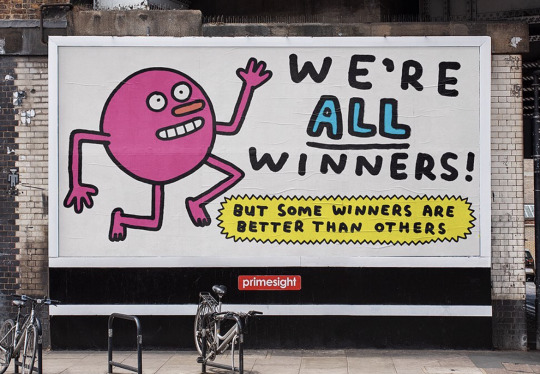
The main point of his talk, Al said, was to reassure those who are nearly graduating, were nervous or worried about our degrees or life as an illustrator, as well as how to make the jump between having graduated and having a job. He shared that he was very scared in his final year, “freaking out” and wondering how or when he would get a job or be employed. Al said he now has an agent, that gets him jobs, and this is the best route to go down. Jobs take all sorts of different forms (such as the one below!). Many of his jobs now are editorial, promotional or for advertising, and he mentioned he would love to do more animation but so far his career hasn't taken that turn.
His work, self-described, is usually character-based and humorous. Every aspect of his brand is bright, colourful and humorous too, including his website and his various social media. One quote from his solo show reads he’s been “described as the Ipswich Town FC of illustration”, in that “he’s been around for a long time but it’s hard to recall any of his major successes”, just an example of the kind of self-deprecating humour he uses in his work and his advertising. Another that also made me laugh was: “having spent ten years living in Berlin and New York he has recently returned to London where he spends his time telling disinterested others that he just spent the last ten years living in Berlin and New York”, which is relevant to our talk, and also funny.
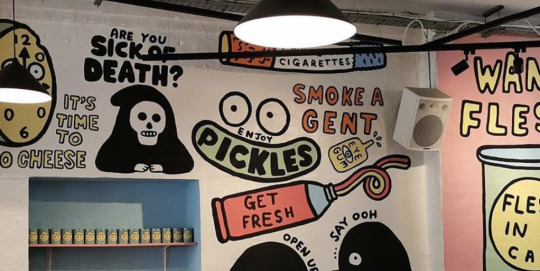
My own work rarely ever includes humour. It’s often character-based, however. I have never really thought about including humour in my work as it’s always been based on aesthetics for me, but it’s obvious that humour has a big hand in Al’s projects and how he gets employed for advertising. It could be worth trying this in future; seeing how humour can incorporate itself into my work.
Similar to Al’s work above, painted on a wall, is that of Sha’an D’Anthes. Although probably less about humour and focused more on ‘cute’ and aesthetically pleasing small illustrations, her work is similarly used below.
I have loved Sha’an’s work for years. I love the colourful nature of it - although the below illustrations on the glass are only in white, most of her work is bright and happy, like the first image. Personally I would love for my work to jump off the page in the same way, however the watercolours I mostly work with don't always allow this. I would like to work in more bright, colourful traditional ways and see how it translates.


Sha’an posts vlogs on her YouTube channel and documents her process, talking about life as an illustrator. It’s a fascinating insight into her career and I would love to do the same with my practice eventually.
Al spoke about his influences and how growing up, you don't always realise that something influences you as its happening. I thought this was an interesting reflection as I always find it quite funny to look back on my work from when I was younger and see how very similar it looked to a Disney Princess film! We collect plenty of influences over the years, all of which have an effect on our work.
Murphy’s work itself is very visually appealing; it’s easy to see why companies want to use it for advertising and promotions. It jumps out at you and is expressive and attention-grabbing.
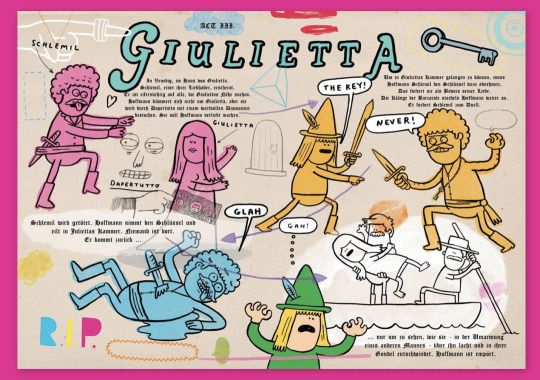
He described a few times about working with companies, big and small. Seeing as much of his work is advertising and promotions for companies, he has lots of experience with this. It’s always interesting to hear about working with brands and how the exchange works, especially as it’s likely I’ll experience this for myself after I graduate. I imagine it’s something you get better at through experiencing it for yourself, and you only really learn through doing, but it’s very useful to hear what companies expect from artists and the different ways they communicate it.
Although not from the talk, an article about Murphy in Creative Boom reads “on the one hand, [advertising] has fed and clothed his family and led to award-winning success, while on the other, it has made him question his own morals as he takes the money to help sell brain-melting products to children”. I thought this was a very interesting point as it is always relevant to discuss what we want from our careers and how we feel our talents are best used to affect the world around us. It’s not necessarily something that’s brought up often, especially as commercial illustration is a very popular road to go down and can be the source of quite a lot of money and success. There’s many other paths in illustration, however, and it’s always worth considering which options make you happiest, which ones you can get the most out of, or which ones you can contribute the most to. At the end of the day, I think creating for a living is a great privilege, and if you don’t love what you’re doing, it’s going to be very difficult to do it.

Simon Spilsbury
Website Instagram
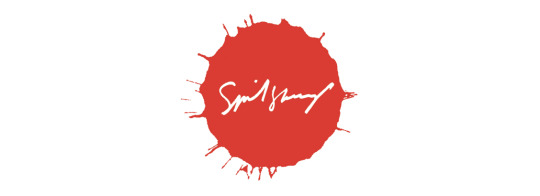
A freelance illustrator, Simon Spilsbury’s philosophy is that drawing, and ideas, are central to process. His website says that his work is “spontaneous, energetic, quirky, inherently humorous, adaptable and elegant”. At first, he said that every day there will be a new image, one that’s never been seen before. I thought this was a wonderful thing to start the talk with - a comment on creativity, and how it’s never the same twice.
He asked us, what sets you apart? In order to be creative, you must make collisions, and take your brain out of its comfort zone. I rarely do this; I’ve always stuck to what I know, especially as everyone says to be successful you need a specific style that people can recognise you by. In Simon’s words, however: “you never know where you're going to end up. If you do, you're not being creative.”

He stressed that your reaction to a brief only happens once. You should make a starting point, and the rest will follow. Personally this is something I struggle with; I find it really hard to bring myself to start something, as often the size of the task scares me. Usually once I’ve broken it down, it’s not so difficult.
Simon also had some specific illustration advice, a lot of it on emotion and expression. He advised that if you want to draw someone performing a specific action, you should do it first. The action also informs the rest of the image. If you're drawing somebody pick up a rock, for example, you draw the rock first.
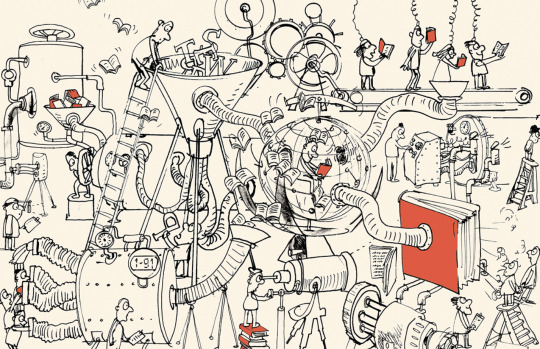
Simon’s practice is centred on drawing. Most of his work is sketchy and illustrative in a way only achieved through pen on paper, or digital pen on digital paper. It kind of captures the way that many artists sit down and absently doodle on a page, a bit like a stream of creativity.
I do most of my work through painting, or through digital software like Procreate. It’s very easy to capture the magic of drawing to Procreate now with very advanced software and plenty of traditional-style brushes. I don't think the emergence of this software changes the creativity that comes alongside drawing and art. Personally, in my head I separate quick, simple sketches on pieces of scrap paper from digital work or painted work as it might take less effort or time. Listening to Simon’s talk reminded me that maybe I shouldn't, seeing as both use lots of creativity. Arguably, quick sketches use more, seeing as they are thought up on the spot and require no planning, brainstorming or practice.
You must understand what you’re drawing, Simon says, with no preconceived ideas. I liked his approach to illustration - it was inspiring to hear about his version of creativity, especially as I haven't felt that creative in a while. My process has become sort of robotic, always the same, often on a screen and through a computer and rarely just for myself. Although Simon didn't address this directly, his ideas about creativity and leaving your comfort zone really struck home with me. I left wanting to do it much more often.
Neil Sheakey
Website Instagram

Neil is a design director at Uniform, in Liverpool, established in 1998, which he described as one of the few companies outside London with a wide variety of creatives. He completed his degree in graphic design at the University of Derby in 2004. He showed us work his company had done with brands like Mitre, Ideal Standard, Innocent and Encona.

His personal creative process was broken down into stages: empathy, perspective, direction, creative and action. It’s always interesting to see or hear about other people’s creative processes, seeing how they differ to our own. Neil also introduced something else interesting, his idea of a 360 experience, also in stages. These were to see, hear, touch and feel, his way of trying out whether and how a brand connects to customers.
Most of Neil’s work is digital and for advertising. He placed a big focus on process, which I’ve not thought about for years. My A-Level Fine Art teacher drilled it into us that process is the most important part of a project. You need plenty of ideas and research to back up your work. I do this a lot for university projects, but not very often for personal projects. I would really like to try this for a personal project and are if it makes any difference to how much I like the finished product.
Neil gave us some useful advice about presenting. If your audience is frowning, it means they are concentrating, which is not a negative reaction. Presenting, he said, means talking about yourself and your ideas comfortably. However, if your idea bombs or does badly, ask questions: why? What can be fixed? How can it be better? I think these questions apply themselves very well to presenting but also to personal work, especially when I have produced something I don’t like (which happens a lot more than I’d prefer).

Most useful was Neil’s 10 tips. He didn't specify them as such, but they certainly are useful tips.
1. Explore - being creative is all about exploration. 2. Find your voice - something that is always talked about in the community. 3. Collaborate - I’ve learnt a lot about collaborating with others this year; people on my course, my friends, etc. It makes me more creative! 4. Think, do, reflect - always look back on your work and see what you liked, what you didn’t, what you can take forward from it. 5. Craft your portfolio - something I forget about! Having one online means people can always look at it, or stumble upon it. 6. Give 100% - I’ve got worse at this. I find it very difficult to motivate myself, but I’m trying harder, because this is something I love to do! 7. Value your time - I’m bad at time management, but my time is also precious, and it does well to remember that. 8. Look after yourself - one of the most important things, if not the most important one. Being creative for a living can be draining and also a lot of pressure. Looking after yourself is essential. 9. Be yourself - your creativity is what can get you jobs, commissions, etc. It’s important that it’s your own! 10. Enjoy it! - of course. Being creative for a living is fun! I’m not as good at this any more, as my whole life is creative now - when I was still doing exams, it used to be my escape rather than my degree, my hobby and my dream career. Hopefully I can get better at enjoying it and appreciating it.
Other Speakers
Due to illness, I unfortunately missed a couple of the speakers we had visit the university, and another was cancelled to to the COVID-19 pandemic. To fill in the gaps, found and listened to some more talks online.

Maria Kalman: The Illustrated Woman This talk was wonderfully random and eccentric. Kalman seemed to really run with the idea of thinking outside the box and almost trusting your first thoughts. She talks of being a dreamy child and dreaming her way though life, all the way until college. Interestingly, Kalman didn’t start drawing until after university. I often worry about where I’m at professionally but I often forget that in the grand scheme of things, I’m still very young. The landscape of illustration is different now than in the 80s, but I still have a lot of my life ahead of me.
An interesting concept she mentioned was “if you know too much, you’re stymied”. This is the second talk this concept has appeared in: Simon Spilsbury also spoke about not knowing where you're going to end up, as if you do, it isn't creativity. Like I mentioned in his talk, this is something I am very bad at. I prefer knowing which direction I’m headed in and I’m often too nervous about a project and how it will turn out to even start it. This talk, and this point, was a brilliant reminder that you can’t plan everything, and sometimes your first thoughts are your best thoughts.

Janet Echelman: Taking Imagination Seriously This was one of those talks where you think it might have changed your life, or at least your outlook. Janet Echelman went to India for an art show and her paints got lost in shipping. As I was listening to this story my heart dropped - I couldn't even imagine what I’d have done in this situation - but Echelman took it in her stride. On a walk, she saw the natives weaving nets on the beaches and sat with them to learn how to do it. Since then, this way of working has become her best and favourite way of working.
I was fascinated by this. As someone that is sometimes too intimidated to try a new type of paint, or to paint or draw a more difficult perspective of something, I found Echelman’s willingness to open herself up to new ideas inspiring. There have been plenty of obstacles in her creative life, but when those arise she simply found ways to solve them. There are often times when I find a challenge too hard, or too intimidating, to even start it. Deep down I know that if I attempt it, even if I fail, I will have learnt something from the experience, and you can only get better through trial and error. Even so, sometimes the nerves I feel about a new project or challenge can overwhelm this logic.
Echelman has carried out briefs for very important clients but despite this, her talk is still filled with the wonder and joy that sparked her creativity in the first place. She places great importance on how art should make you feel, and how you should strive to create things that make other people feel something too. It even made me tear up at the end.
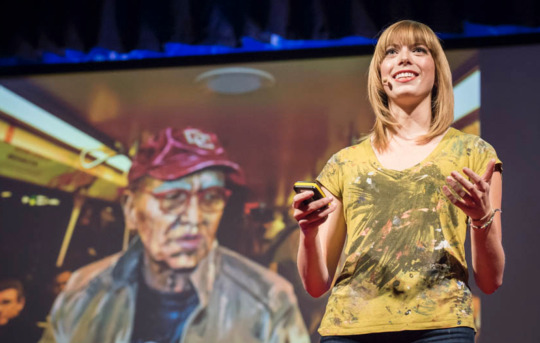
Alexa Meade: Your Body is my Canvas A reoccurring theme with these talks for me is how good these creatives are at simply new ideas. I think the idea of creativity has taken a back seat for me over the years, and I know at A Level and GCSE there was a big focus on technical precision and talent instead of just having a good idea, and running with it. Although my degree places importance on elements of this, in my work it seems to have disappeared. Maybe creativity comes quite easily to me, in that I’m given a brief and instantly have ideas to put down, or maybe I've forgotten about it altogether, and I’ve managed so far to work without much of it. It might be that creativity is different for all of us. This talk still serves as a reminder that we should always be trying to access our creativity in everything we do.
Meade seems to have creativity down pat, however; if you could describe it, it would be this. Her work is fascinating in that she doesn't paint on canvas, but she actually paints on the subject she is painting. What comes from this is what looks like two dimensional paintings, but is all 3D. These talks are all inspiring, but Meade has taken an idea from the past and made it into a career that nobody else had done before.
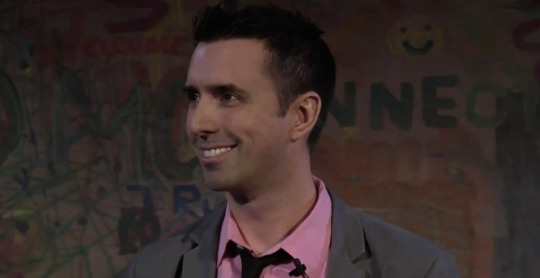
Jarrett J. Krosoczka: How a Boy Became an Artist There is something so inspiring about holding art and creativity so close all your life, and Krosoczka’s story is this exactly. It places huge importance on using your imagination: “writing is using your imagination on paper”. It was another wake-up call to be reminded that at the basis of what we do as creatives, we’re always using our imaginations.
“Celebrate your own style” is among the wisdom in this talk. Krosoczka had a turbulent life but recognises and passes on the importance of good stories, for children specifically. There is a confidence that is threaded throughout his talk and his life, almost like willing something into existence. Again, it’s inspiring to see someone with the confidence to know that whatever happens, it’s always possible to meet your goals and fulfil your dreams. In a creative career it’s easy to let adversity get you down, but it’s also amazing to look back on your life so far and celebrate the achievements you've made.
What I took away from this talk is a reminder that even if I feel down about my art or my abilities, I always have the tools to get better and develop. I think this is something always worth remembering.
A few other links to interesting talks/podcasts I found by artists:
Anthony Gormley in Conversation with Iwona Blazwick
Tracey Emin RA on her largest-ever text piece
Building a successful career as an illustrator with Furry Little Peach
RCA Talk with Subject Matter: Women Artists & A Brave New Art World
Béatrice Coron: Stories Cut From Paper
In Summary
All in all I enjoyed the talks. It was inspiring to get a fresh perspective on art, illustration and creativity, especially as we often seek out ideas similar to our own and flock to people that share them. Naturally it was useful and equally as interesting to hear from people established in their fields, how this came to be, and even how they felt - and now feel - about it.
It was also a bit of a wake up call as I know plenty of people, me included, tend to stay focused on the present and the work they're involved in right now, instead of making plans for the future and looking ahead. I don't think it’s advisable to plan out every aspect of my future, but I rarely think about it. It was interesting, fun and quite daunting to sit on the train on the way home from some of the talks and imagine a career that spans as long as some of our speakers. Maybe one day I’ll give a talk of my own!
One criticism I have with the talks is the lack of diversity. I understand it is difficult to get people in to give talks, but one thing I noticed as soon as we got a list of who was visiting was the lack of women on it. I was hoping to get more of an insight into women in the industry. Instead, this was something I sought out myself; the extra talks I needed were mostly by women. Of course the women giving these talks were equally fascinating and knowledgable.
This concerns other aspects too, not only gender, as it would have been interesting to hear from people from different backgrounds and different ethnicities, as all of the speakers we had visit were very similar in that respect. It’s interesting to hear from anyone in the field, but I’m sure people from different walks of life would have something extra interesting to add to their talk or something different in their story to share. Not only for me, for my own curiosity, but also for other students that come from somewhere different to me, somebody that might appreciate a different insight that they can relate to. It would be easy to feature this in a range of visiting artists.
I felt there could have also bee variety in types of illustration, as the talks I heard were mostly from those in advertising and promotions (of course, the two I missed due to illness may have been different). I know Louise Lockhart, the final talk that was cancelled, is a children’s book illustrator, and gives me all the more reason to be disappointed about missing it! There are so many different ways to use skills and experience in illustration and although advertising is a very common one, it would have been useful to have more variety in this aspect.
Of course, it’s always encouraging and refreshing to hear from established artists and to take away something from a talk. There’s always something you can learn. Even with the extra talks I needed, I felt more and more interested with every one I listened to, and felt encouraged to find and learn more. It strikes me that with platforms like YouTube and Instagram, where we follow and subscribe to fellow artists and creatives, we are doing the same, always wanting to find out more and learn from people around us and people we admire.
0 notes
Text
pitt rivers museum and oxford
Whilst Platform for Joy was still a group project, we travelled to Oxford to visit the Pitt Rivers Museum and surrounding area.

The Pitt Rivers Museum was founded by Augustus Pitt Rivers in 1884 and is home to the anthropological and archeological findings of the University of Oxford. Pitt Rivers donated his private collection to the University on the condition that they appointed a permanent lecturer of anthropology.
There are over 500,000 items in the collection. This number has grown from the original collection of 22,000 items, due to the donations of scholars, dealers, auctions and other members of the Archeological Institute.

The museum itself is very odd, and is a bizarre explosion of culture, history and anthropology. It was so interesting to step downstairs and suddenly be immersed in so much of this from around the world. Of course, this is the beauty of a museum, especially one such as this, and it is clearly the reason why Pitt Rivers thought these items were worth displaying.
The museum is organised differently to many other museums: the collection is organised by how items were used, as opposed to the time period they came from or geographical area. The museum is actually famous for this type of display. Pitt Rivers themselves state this is “to show how there are many ways of being, of knowing and of copying. Parallels and juxtapositions show how there are a great diversity of ways to solve similar problems in different time and by different peoples”.
It works, too - it is indeed fascinating to see how certain items changed and were adapted over time for ease of use or to follow trends, or how different cultures approached the same concept. It works even if you don’t realise that’s specifically why or how they do it. It’s a very different, but effective, way of navigating and displaying parts of history.

However, doing even a small bit of research uncovers an issue with the displays at Pitt Rivers. An article on Cherwell.org writes that this method “deprives the museum displays of much contextual information”. For example, a display about opium in China leaves no mention of the Opium Wars or the British involvement in China’s opium trade. There’s no mention of how the artefacts came to be at the museum, as then perhaps Pitt Rivers would have to publicly admit it was mostly as a result of stealing from around the world.
Like many museums, the Pitt Rivers Museum struggles with controversy over the origins of their collections. This was also at the front of my mind as I looked around, as such issues are nowadays part of a very public discussion, concerning huge institutions like the British Museum.

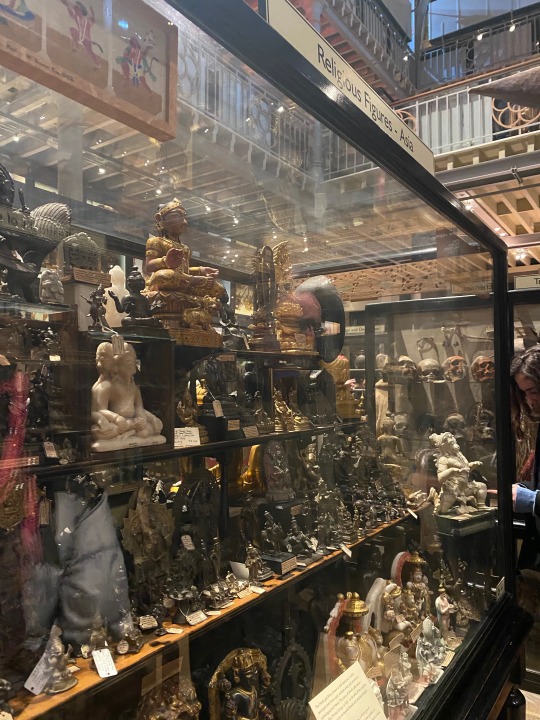
Of course, it is important for all museums to educate about culture and society across the globe, but there are ways around this. Plenty of museums work kind of like libraries or galleries, receiving items on loan to display and for people to learn from before they return home. It’s equally as important that such items are allowed to go back to where they were taken from, as they are much more important to culture and history there as they are in England. At home they form part of a country’s national identity - in fact, around 2,000 of the items held at Pitt Rivers are classed as human remains, some of which are only recently being repatriated.
One interesting point I read in the Cherwell article was from Sarah Bourke, , who says that “the museum needs to work towards reducing the power imbalance between themselves and source communities”. This is a clear point where this issue is concerned, as often the communities working to see part of their history returned to them are much smaller and poorer than huge and powerful institutions like the British Museum or Oxford University.
It’s a difficult problem to navigate, but the museum is allegedly working with museums and collections abroad to right these wrongs. They are working to repatriate objects and send them home, although this offer is only open to those with a direct genealogical link to the remains at Pitt Rivers. The Cherwell article states that “with museum directors, academics, advocacy groups and students all agreeing in principle, decolonisation seems more a matter of execution than persuasion at this stage”. Of course this is hopeful, and at least the museum realise and acknowledge their impact on culture and society, and the importance of this issue globally.
The Pitt Rivers Museum also makes it possible to view their collections online. Due to the COVID-19 pandemic, the museum is closed to the public, but are offering a virtual tour, also on their website.

The Pitt Rivers Museum is only accessible through the Oxford University Museum of Natural History. Like Pitt Rivers, this museum exhibits much of the University’s natural history specimens. It is the UK’s most visited non-national science museum, home to around 7 million objects and 30,000 zoological specimens.
It has some very important historical claims, such as hosting The Great Debate in June 1860. Samuel Wilberforce, Bishop of Oxford, and Thomas Huxley, a biologist from London, fiercely debated one of the most controversial ideas of the 19th century: Charles Darwin's theory of evolution.
Of course the Natural History museum has dinosaurs on display, which are fun and interesting at any age. There’s a reason why Jurassic Park made so much money.

This girl gets it.
Personally, I often find these museums more interesting than museums of anthropology, and much easier to enjoy without approaching a glaring moral issue at every turn. It’s just so fascinating to step in front of something from such an incredibly long time ago and have it there, clear as day.

Also, birds.
It’s also possible to navigate the Natural History museum’s collections online, through their website, and their collection highlights.
I’m not sure how useful this visit was for our Platform for Joy project, as instead of making me feel much joy the Pitt Rivers Museum led me down a road of research into colonialism and repatriation. Of course this is a very important issue and was very interesting to look into, and it does bring me joy to learn things and educate myself on such topics, but it would be difficult to bring that to a train station platform. Perhaps education could be an important aspect to include in the project.
Oxford itself is a lovely place, despite it raining throughout our entire visit. I really love places that are a slice of history, almost like stepping back in time. I enjoyed looking through bookshops and little corner shops and passing small cottages by main roads - and, of course, the colourful pastel houses.

0 notes
Text
a few virtual tours, a few real tours
In this strange and unusual time of lockdown for the world, one of the biggest losses to culture and society is that of galleries and museums. They are widely visited daily, across the globe, allowing generations of people to learn about and appreciate works of art and aspects of history.
Despite this, we also live in a time where people can connect very easily online. Although some people often find this tiresome or useless, instead believing people should go out and see the world for themselves, it has proved insanely useful with current events: many galleries and museums have found a new way to use this to their advantage.
Seeing as we cannot make it to our Design Connections event and talk to artists and practitioners about their current work, I thought it would be enlightening to look back on some of the works I’ve seen before that are of historical and cultural importance, and perhaps discuss why this is and how it came to be. Also, with the additional help of some of the virtual tours now on offer online, I can take a look at some works I have yet to see, and examine those too - perhaps offering insight on why I wish to visit them.
London, April 2018
One of the most well-known galleries in the world is The National Gallery, situated in London’s Trafalgar Square. It is home to many renowned artworks by lots of famous artists. I have been a few times, most recently in April 2018.
I love the National Gallery not only for the art it houses, but for the architecture. It’s one of the best places in London just to sit, maybe near your favourite painting, and watch the world go by as tourists skim past art by some of the most renowned artists in the world.
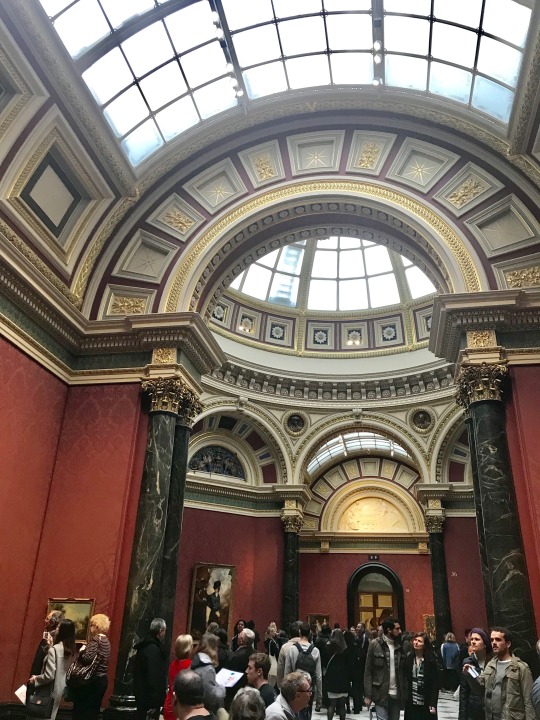
Every month the National Gallery list on their website a ‘picture of the month’, one picture from their gallery, to spotlight. April 2020′s picture of the month is one I actually took a picture of myself, in the same month two years ago. It is Akseli Gallen-Kallela’s Lake Keitele, painted in 1905 as he was recovering from malaria. Lake Keitele is in central Finland, and Gallen-Kallela, a Finnish artist, was captivated by the view. He painted it multiple times.
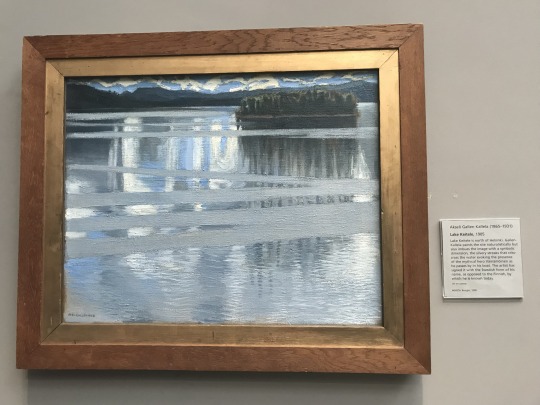
The painting is captivating, too, a mix of bright reflections and dark, sombre shadows. The National Gallery website writes that “strips of steel-grey zigzag boldly across the surface of the lake. They capture the effects of wind moving across the water and the currents beneath”. Gallen-Kallela imagined these to be down to a passing boat. The artist expressed his love of Finland through art, in a time when Finland was trying to gain independence from Russia.
Below is one of my favourite paintings of all time, displayed in the National Gallery. It was painted in 1889 by Vincent Van Gogh, one of the most famous artists of all time, and is called A Wheatfield, with Cypresses. Whilst a patient at Saint-Paul de Mausole, a psychiatric facility in the south of France, Van Gogh painted several versions of the same wheatfield. The one at the National Gallery is the final version.
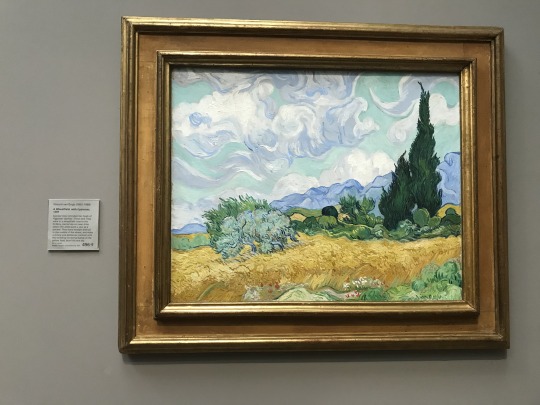
Arguably, the vast majority of Van Gogh’s artworks have captured the hearts of the world, long after his death. He paints rhythmically, with swirling brush strokes that capture the movement of nature. This particular painting boasts this effect beautifully; vincentvangogh.org notes how the Cypresses stand vertical and contrast the many horizontal aspects of the work. They also note more contrasts, such as the contrast of warm colours versus cool, or sky versus land. One quote of theirs I particularly enjoyed: the work is dubbed “restless beyond measure”, which is a common feature in Van Gogh’s work. This is a perfect example.
Athens, September 2019
Athens is home to the Acropolis, and subsequently the Parthenon, which is probably the most iconic imagery associated with Ancient Greece. It has been a source of endless fascination for centuries, across the world.

Athen’s The Acropolis Museum is a much more recent museum, opened in 2009, filled to the brim with Ancient Greek artefacts excavated from the Acropolis itself. It was purpose-built to house everything found on the hill and surroundings, and there are plenty of them.
In fact, the whole of Athens seems dedicated to its history, as even the Metro stations exhibit artefacts dug up in their construction.
The Acropolis Museum is built over yet another archeological site, an ancient neighbourhood complete with a drainage system and bathhouses.
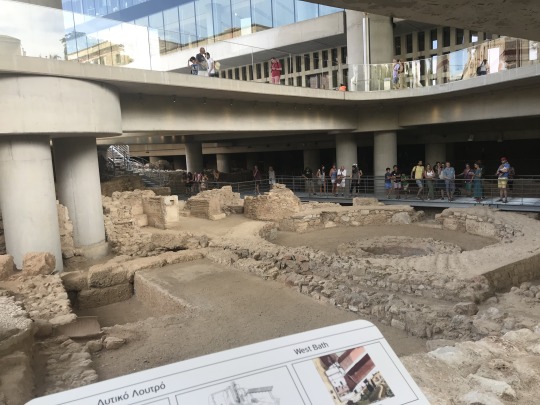
Much of the floor in the museum itself is made of glass, allowing the endless stream of visitors to view the site beneath. At the entrance to the museum there is a large drop where the remains of a bathhouse are in view. There’s also a walkway under the museum where visitors can tour the archeological site, and it is incredibly odd but also kind of touching to be immersed in ruins where people actually lived, thousands of years ago.
The Acropolis Museum, as by name, is a museum, rather than a gallery. However one area of the museum, the Archaic Acropolis Gallery, is full to the brim with sculptures and statues. Archaic refers to the period from 8th century BC until the end of the Persian Wars, or around 480 BC. This period saw immense changes in Greek language, society, art, architecture, and politics, due to the increasing population and usage of trade.
The exhibits in the Archaic Acropolis Gallery are beautifully presented on large white podiums. It is strictly no photographs, so I took none of my own (the one below is from the museum’s website). This way of exhibiting offers tourists a way of viewing the artefacts from all sides. The gallery is lit mostly using natural light through giant windows, and as the light shifts outside, the way the statues can be viewed changes too.
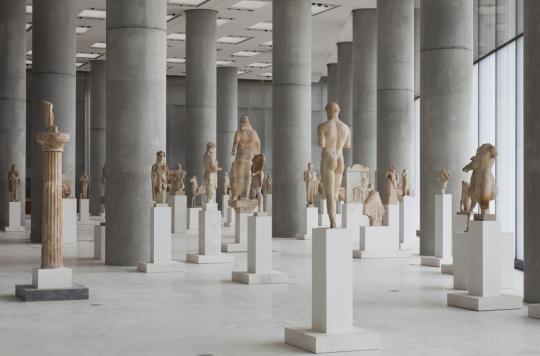
Also open is the museum’s Parthenon Gallery, seen below. It houses many of the famous Elgin Marbles, which were originally part of the Parthenon and other buildings on and surrounding the Acropolis. Most of the Marbles were removed (or stolen) by Lord Elgin who moved them to England in 1812, where they were bought by the British Museum. There has been much international pressure for them to be returned to their rightful place, especially now the Acropolis Museum houses the rest of them, but this is yet to happen. The Parthenon Gallery in Athens leaves spaces in the exhibition for the stolen pieces and displays casts of others, so it’s easily visible where the originals should be.
The sculptures once displayed on the east pediments of the Parthenon tell the tale of the birth of the goddess Athena, while those on the west depict a battle between Athena and the god Poseidon to determine who would be the patron deity of Athens (LiveScience). Although the Marbles themselves and the stories they tell are beautiful and important to Ancient Greek history, much of their coverage and popularity worldwide is down to the repatriation debate.
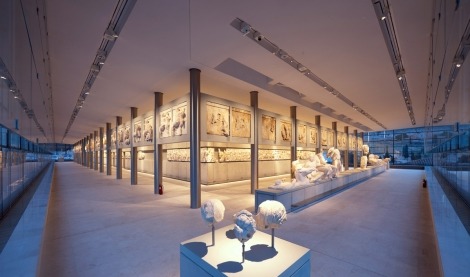
I adored Athens. I’ve had an interest in Ancient Greece since I was very young, and of course the capital city is the best place to visit for this purpose. It was such a joy to walk alongside the Acropolis, or to turn random corners and see a part of ancient history in the middle of the street.
Many people share this with me. For an incredibly long time Greece was the leading nation in politics, art, philosophy, society and culture, as well as the birthplace of democracy. Athens, as the country’s capital city, was an obvious epicentre. History.com write that “over the centuries, the Acropolis was many things: a home to kings, a citadel, a mythical home of the gods, a religious centre and a tourist attraction.” All this has led to a fascination among historians and tourists alike.
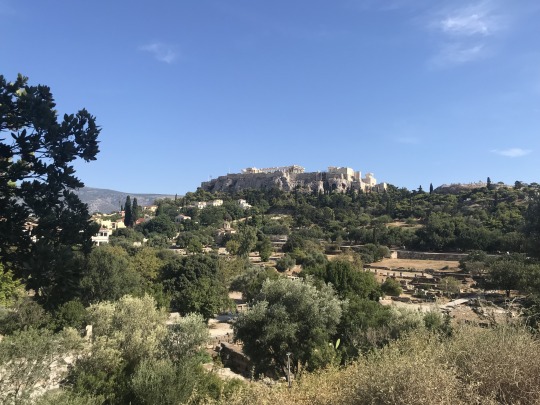
The Parthenon has been standing for over 2,000 years. It has obviously deteriorated over time, but it’s still there, and is now being renovated in a multi-million euro project. It is visible far and wide in Athens, and is an iconic symbol of not only Greek antiquity but ancient history as a whole.
It’s no wonder why the Acropolis Museum is so immensely popular. Stacked full of artefacts and pieces of history, it’s like stepping into the past.
The museum is part of Google’s Arts and Culture galleries project and therefore can be visited online, too.
Paris, January 2020
The Musée de Louvre is one of the most famous museums in the world, and for good reason. I loved wandering the halls on my trip to Paris, even when the fire alarm went off for a solid twenty minutes and not one person left in haste (truly, truly French).
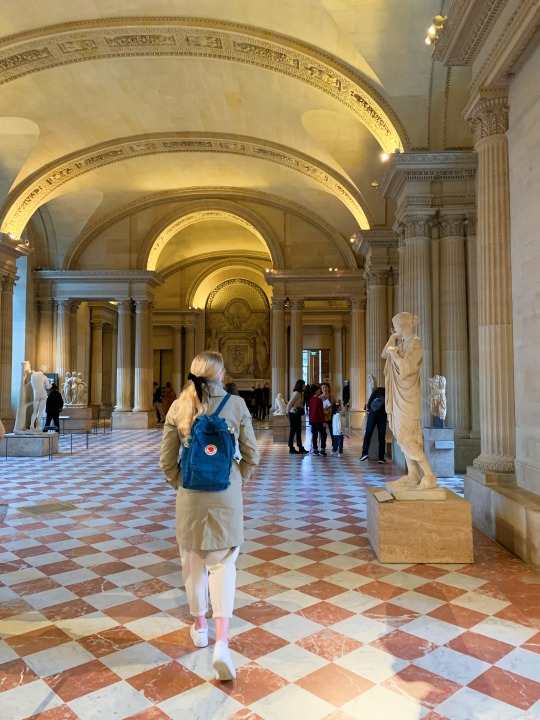
Like the Acropolis Museum, the Louvre is more of a museum than a gallery, and there are hundreds and hundreds of artefacts at the Louvre. However, one painting is the Louvre’s pride and joy. People visit the museum specifically to see Leonardo Da Vinci’s Mona Lisa, easily the most famous painting in the world. There is a carefully guarded and staffed queue system you must stand in to view the painting up close, and even then it is behind bulletproof glass (in 1956, somebody threw acid at her!).
The Mona Lisa is a perfect example of an image or painting captivating the world, and is clearly of great historical and cultural importance. Plenty of people before me, with far better knowledge and understanding, have tried to describe why exactly the Mona Lisa is so popular. Encyclopaedia Britannica’s article “Why Is the Mona Lisa So Famous?” theorises there is no single explanation, but there are plenty of reasons why the painting draws thousands of ardent admirers daily.
Clearly, the painting is very realistic and displays great technical ability. There are plenty of technically good paintings, however - in fact, the Mona Lisa is surrounded by them at the Louvre, and in the many galleries of Paris.
It could be the painting’s journey that proved it to be so popular. It became more and more well known as it travelled around France, first in the court of Frances I, King of France and part of the royal collection. In the French Revolution the collection was claimed as the property of the people, and it was only after a period in Napoleon’s bedroom that it was given to the Louvre.
The mystery of the painting’s subject has allowed the public to project an identity onto the Mona Lisa. Scholars theorise the portrait is of Lisa Gherardini, wife of the Florentine merchant Francesco del Giocondo, but there’s no proof of this as no record of a commission can be found. The speculation surrounding the painting is as much a part of culture than the painting itself.
It’s even possible that the Mona Lisa is possible because in 1911, it was stolen by Italian immigrant Vincenzo Peruggia. He was tried and imprisoned before he could sell the painting, which proved impossible due to its popularity. The ensuing media frenzy cemented the portrait into popular culture, where it has stayed for over a century.
Subsequent tours of the USA and Japan have helped it gain worldwide fame, as well as pop artists using her likeness to challenge what it means to make art and worship it. With the emergence of computers and the internet, the Mona Lisa began to be endlessly reproduced and again rose to immense popularity, to the point where I asked my sister, who has no interest in art, to name a painting - her reply was, naturally, “the Mona Lisa”.
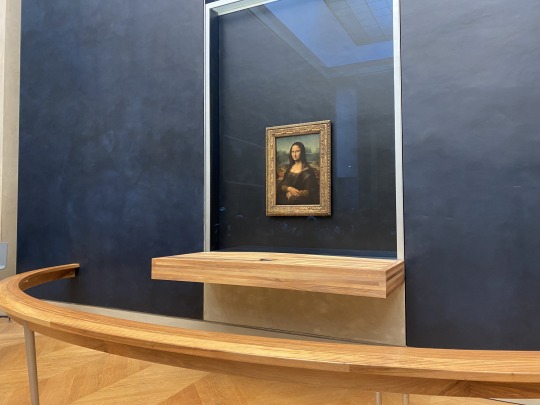
In all honesty, the Mona Lisa is obviously part of history and I am very happy to have been able to visit her, but the Louvre is so expansive and full of interesting and beautiful things that she might even have been a little underwhelming. After all, you can't get too close, and she is behind glass. Perhaps more interesting was the painting she is facing, if only for the sheer size of it. The Wedding at Cana by Paolo Veronese (1563) depicts the biblical story of the Marriage at Cana, at which Jesus turns water into wine. It is the biggest painting at the Louvre, yet one which people often miss, what with the excitement of the painting it faces.
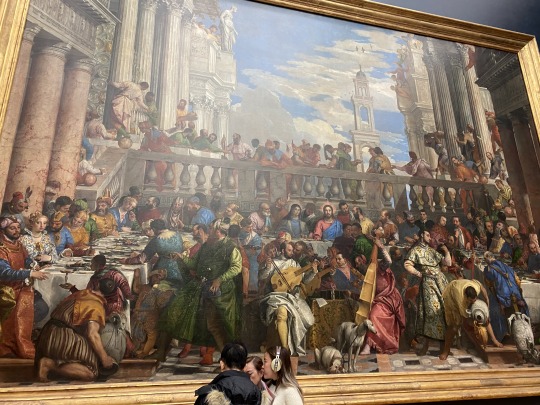
The Venus de Milo is also housed at the Louvre. It is an Ancient Greek statue thought to be the work of Alexandros of Antioch. It is believed to be a depiction of Aphrodite, but could also be of the sea goddess Amphitrite. Amphitrite was venerated on the Greek island Milos, where the statue was discovered in 1820. The statue was built from two blocks of marble and is comprised of several pieces all joined together, fixed with vertical pegs. The Louvre writes that this was common in Greek sculpture, especially in the Cyclades around 100BC, when the Venus de Milo is thought to have been sculpted. The statue is named after the Roman name for Aphrodite, ‘Venus’, and the island of Milos. Her arms were never found.
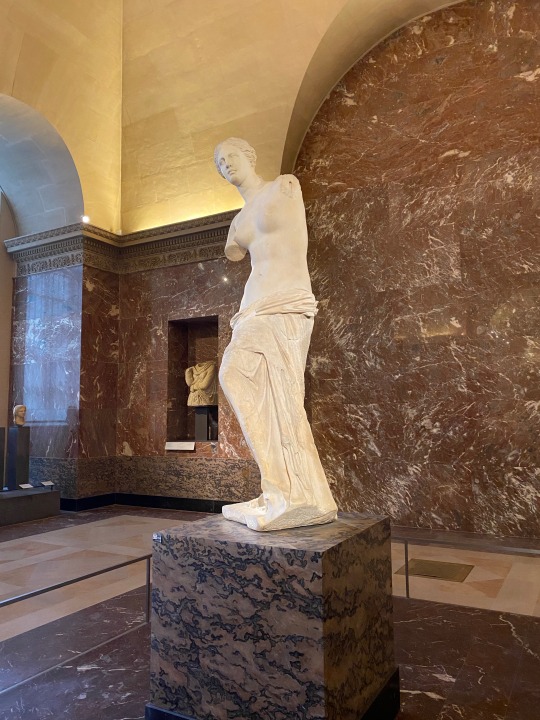
The Smithsonian note that the Venus de Milo is the most famous sculpture in the world, and “after the Mona Lisa, the most famous work of art in the world”. Despite many sculptures like it, and most sculptures from this period looking incredibly similar, she is immediately recognisable due to her missing arms. It’s probable that with her arms, the Venus de Milo would be way less popular.
She is posed in an ‘S’ curve, a feature traditional in Ancient Greek and Roman sculpture. The technique allows a more realistic distribution of weight. My Modern Met theorise she was likely “colourfully painted and adorned with jewellery, though no pigment or metal remain on the marble today”. The Louvre acknowledge that holes remain where the statue was originally adorned in metal jewellery.
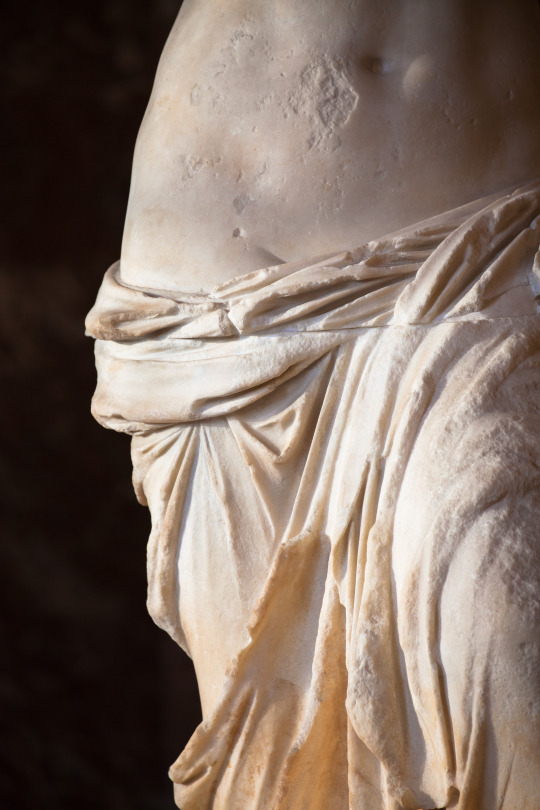
Bradley Weber, Wikimedia Commons
Bob Duggan writes in his article “How the Venus de Milo Changed Female Beauty” that female nudity was not common in art and sculpture in Ancient Greece, whilst male nudity was common due to the lack of clothing in sport and competition. It wasn’t until 350 BC that Praxiteles began to sculpt the female form, and even then, the sculptures were rarely nude, instead draped in fine clothes that hinted at their outline. Venus de Milo comes way after Praxiteles, but clings onto this trend with a draped lower half.
Like the Mona Lisa, the Venus de Milo has become a staple of classical art and an iconic representation of sculpture and Greek antiquity. It can be found everywhere, including one particular episode of ‘The Simpsons’ in 1994.
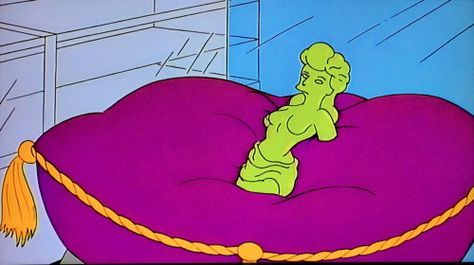
Screencap via Tumblr.
Also like the Mona Lisa, the Venus de Milo owes much of her popularity to modern art and propaganda: in fact, a specific propaganda campaign by the French in 1821, when it arrived at the Louvre. They were incredibly excited by her arrival, as the British had just bought the Elgin Marbles ripped from the Parthenon, and the Apollo Belvedere was returned to the Vatican. France were in need of an exhibit from classical Greece and, like magic, along came the Venus de Milo. However, the Venus de Milo was actually sculpted half a century after Greece’s classical age, and the Louvre's director Forbin allegedly hid her base to hide this fact.
The Art Minute write that “surely, the Venus de Milo is idealised: the features on her face are symmetrical, her breasts are small, her hips are wide, and her body is fleshy and soft”. She is the perfect example of beauty in Greece’s classical era, much changed from then to now, and offers us insight into female beauty in Ancient Greece. This was clearly their ideal if the goddess of love, beauty and sexuality was sculpted this way.
The article also says that “her twisted posture invites viewers to walk around all sides of her magnificent figure in order to see every curve and bump in her lovely form”, describing exactly what it’s like to be in her presence. Venus de Milo is 6′8″, and this affects her presence greatly also. Speaking from experience, it truly affects you to turn the corner and see her towering above you, knowing you are in the presence of part of history.

The Louvre was one of the best places I’ve ever been, and certainly one of my favourite things in Paris. It was a real bucket list moment. If you’re not lucky enough to visit the Louvre in real life, you can do it through a screen too.
Musée d’Orsay
I didn't have time to visit the Musée d’Orsay when I was in Paris, but it would be first on my list if I were to return. It houses the largest collection of impressionist and post-Impressionist masterpieces in the world, mainly French art dating from 1848 to 1914, and subsequently is home to many of my favourite artists and paintings.
Google Arts & Culture have many virtual tours available, and the Musée d’Orsay is one of them. I was delighted to find out you can essentially stand in front of some of the most famous paintings in the world, only from home, maybe in your pyjamas with a cup of tea.
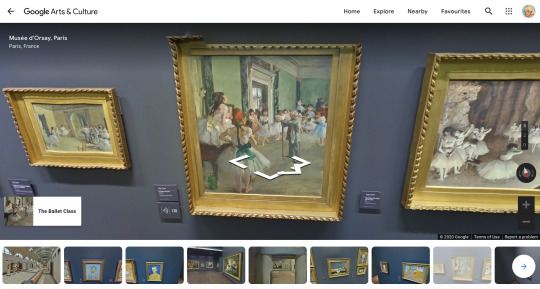
Above is The Ballet Class (or La Classe de Danse), by French artist Edgar Degas. Degas is famous for his depictions of ballerinas, as over half of his works contain dancers. The most notable of his works is the sculpture Little Dancer Aged Fourteen, the original of which is exhibited in the National Gallery of Art in NYC. Although Degas is a noted Anti-Semite and objectively cruel person, when it comes to his work I deploy a philosophy of separating the art from the artist, as I have always loved his delicate portrayals of young ballerinas in their studio.
The accompanying information given with The Ballet Class by the Musée d’Orsay reads: “more than the stage performance and the limelight, it was the training and rehearsals that interested him. Here the class is coming to an end – the pupils are exhausted, they are stretching, twisting to scratch their backs, adjusting their hair or clothes, an earring, or a ribbon, paying little heed to the inflexible teacher, a portrait of Jules Perrot, a real-life ballet master”.
This painting is captivating perhaps due to the theory of voyeurism. As the viewer, we are looking in on a scene captured from real life, without the people in it having any knowledge we are there. We have an insight into a practice most people don't see, especially people like me who cannot dance at all.
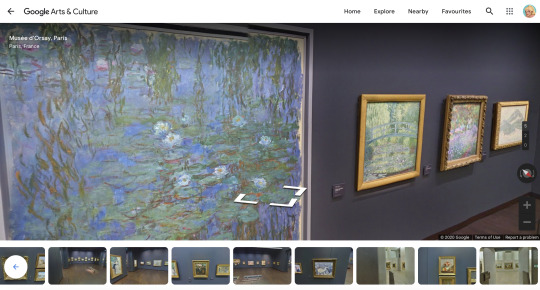
One reason why I've always wanted to visit the Musée d’Orsay is to see some of the paintings by Claude Monet. Many, many people hold Monet in high regard, listing him as one of their favourite artists, and I’m among them.
Monet bought a house in Giverny, France, in 1893. From then on, the house and its gardens became his main source of inspiration, mostly including the water lilies he planted in his water garden. Many of his paintings focus on these - the series consists of around 250 paintings - and they have become his most famous works, displayed in museums around the world.

The above painting, Blue Water Lilies (or Nymphéas bleus) focuses on a very cropped, specific area of Monet’s water garden. It features few details, instead using a very abstract brush stroke and instead using colour to hint at shapes and forms. The Musée d’Orsay write: “never was the artist's brushstroke so free, so detached from the description of forms. A close-up view of the canvas gives a feeling of total abstraction, because the brushstrokes are stronger than the identification of the plants or their reflections”.
As well as this, the gallery also suggests why the painting, and those much like it, are so captivating: “the viewer has to make a constant visual and mental effort to piece together the landscape suggested in the painting”. The paintings that we really have to think about are often the ones that stick in our minds.
Although I will make it my goal to see these paintings in real life too, I found them through Google Arts & Culture’s virtual tour.
Musée de l’Orangerie
Also the home to many paintings from Monet’s Water Lilies series is the Musée de l’Orangerie. Although the museum displays works by other artists like Jean Walter and Paul Guillaume, they are most famous for their Monet collection.

As part of his Water Lilies series, Monet painted several murals. During the 1920s, two oval rooms were built at the Musée de l’Orangerie to house eight of them, and they are still there today. The above is The Water Lilies - Morning. Together, the murals show the passage of time through the day. The light shifts and changes throughout all eight, as the museum notes that “as of 1886, Monet became more interested in representing his garden according to the rythm of light variations”.
Monet’s wild popularity may be down to pure aesthetics. He painted beautiful paintings, beautiful scenes that were pleasing to the eye, using colourful palettes and free and loose brush strokes. It could be that the water lilies themselves aren't the reason why the painting are so popular. Monet ‘zoomed in’, as such, on the water itself, cropping the edges and removing the image of any horizon or skyline.
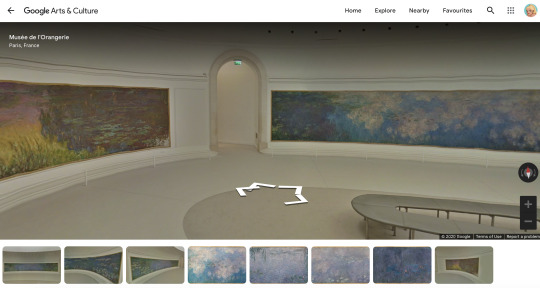
Thames and Hudson say “the works become less and less about constituent elements and orientation, and more about the energetic gestures of paintbrush and pigment... there is no frame, no single resting place for the eye, only an immersion in planes and passages of colour”.
There’s an element of freedom, and clear adoration from Monet for his surroundings, which maybe we share with him whilst viewing. The artist himself said “the water-flowers themselves are far from being the whole scene. Really, they are just the accompaniment. The essence of the motif is the mirror of water, whose appearance alters at every moment.”
I toured the Musée de l’Orangerie and the Water Lilies murals using the same method as done previously, here.
More to See
If you too are stuck indoors in 2020, or are finding this post in the future and enjoy sitting looking at paintings from the comfort of your own home, you can find lots of other virtual tours below.
The National Gallery, London, UK
National Portrait Gallery, London, UK
The British Museum, London, UK
Vatican Museums, Vatican City, Italy
The Uffizi Galleries, Florence, Italy
Picasso Museum, Barcelona, Spain
The Guggenheim, New York City, USA
The Museum of Modern Art, New York City, USA
0 notes
Text
studio visit
For my studio visit, I went to see and speak with Sue Pryke. Sue is an award-winning home and tableware designer and ceramics artist based in Leicestershire. According to her website, Sue is “inspired by the everyday and the ordinary; material qualities, textures and the interaction we have with objects”.
What did you do at school? Which subjects were your favourites? Sue went to an all-girls school. In her own words she was not particularly academic, and there was no talk of university. She was, however, always good at art and loved drawing. When she did her A Level in art, she had to pick a craft, and of course Sue chose ceramics. She loved the class and the teacher - in her interview with The Whistle Sue says you could often find him meditating on the tables at lunchtimes - and a whole world opened up with clay.
After school Sue went on to do a degree at Leicester Poly, entering an RSA competition in her first year and winning. Sue took advantage of the Erasmus scheme and did slip casting in Amsterdam and loved the more industrial way of working. As a competition prize, Sue won ten weeks work experience at Wedgwood as a designer.

From Facebook.
When did you decide to make this your full time career? “I just kept doing it!”
The ten weeks at Wedgwood gave Sue lots of opportunities to learn and she was excited to be in the industry. Her website states that it was “A wonderful place to begin a career in ceramics, steeped in history and with such a rich heritage to draw on daily”. Eventually, however, she got bored, and went to the Royal College of Art to do an MA. After this, Sue set up a studio in London producing tableware for stores such as Conran Shop, Heals, Liberty’s, as well as designing for other companies. Eventually, Sue moved back to the Midlands and ran the ceramics course at De Montfort University.
Sue has been in many, many creative roles. In 1994, someone from Ikea visited. Sue has designed for companies, trade fairs, completed big orders for shops produced in factories, and began producing her own work under her own name. She was the Sainsbury’s homeware studio manager and left De Montfort. In her words she produced lots of “beautiful things” for Sainsbury’s that never saw the light of day, as the brand was going in a different direction.
What does your work week look like? Every week is different. Sue makes in studio, does freelance work in design consultancy, works with factories, does a bit of teaching. In her words, she likes to “keep all the balls in the air”!
To date, what is your favourite project to have worked on? A stand out is a project called Ikea 365+, first designed in 1995 alongside a team of three Swedish designers. The brief was something that can be used every day, a satellite range that can be added to, something everyone could buy and utilise. The range, although recently revamped, has been around for 30 years.
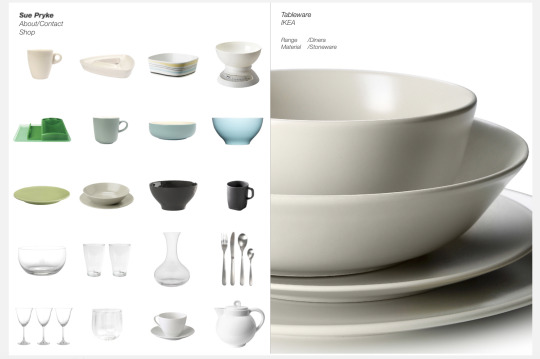
Another project that stands out for Sue is much more recent: the Stratford Hotel in East London commissioned her to design and make tableware for their two restaurants. The hotel opens in July 2020. The project involves masses of organisation, and is the first time Sue has ever made anything on that scale.

What is your favourite part of your job? Fettling! A technique that involves smoothing and rounding off edges, Sue enjoys this process as it offers an opportunity to practice something mindful, and takes you into your own world. You can zone out, for example to a podcast, a play or a piece of music, and when you hear that again or take up your task again you are reminded of that specific situation, or specific piece of work. It involves making decisions unconsciously, using your own personal judgement to finish a project. Different employees make different value judgements, and this kind of work can make or break a project - making the final call can be difficult and make a big difference.
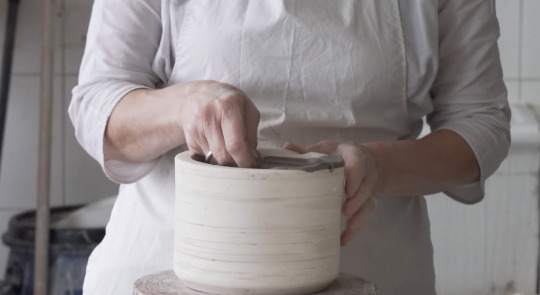

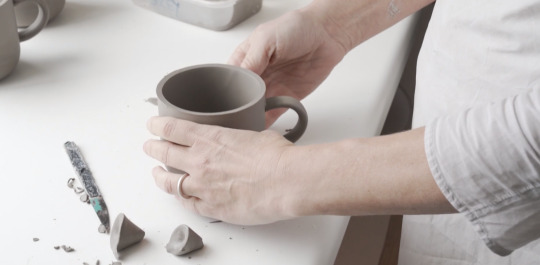
Sue slip-casting a mug, shot by Natasha Tonkin. From Vimeo.
What is the most difficult part of your job? Initially, Sue laughs and says, “so many!”. Coming into the studio is sometimes difficult, and office work can be dull, especially accounts, admin and the like. New projects are always exciting, but can get boring quickly, no matter how big the project. Unlike myself, who finds it difficult to start things because of the scale of a project, Sue finds it much more difficult to finish them, and she says this probably why she has so many things on the go at all times. Being mid-project also means working very long hours, which is also hard.
What in your career are you the most proud of? At first Sue lists aspects of her earlier career: work for Ikea, her time at Wedgwood, but then she laughs - “We haven't talked about the telly yet!”. On the most recent series of The Great Pottery Throwdown Sue was a judge, and she lists this as something she's very proud of.

Her career laid the foundations for something like television: her years of experience as a practitioner gave her the skills in designing and making to back up her feedback and as a teacher, she is good at delivering the feedback too. The timing, she says, is perfect. She is experienced enough to have the confidence to do it and has mixed with so many people over the years to gain this experience.
Finally, do you have any advice for young artists? Ask questions! About anything and everything, even if you already know part of the answer. Talk to technicians, use the staff, interview makers and designers, find out everything there is to know. Do more competitions and take all the travel opportunities you can get. As Sue remarks, you won't know until you get the experience. In an interview for Design Nation Showcase, Sue also advises to “just do what you love”!

Glassware designed for Ikea in 2017 from Sue’s website.
Sue can be found on her website, Facebook page, Instagram or Twitter. She has a separate page for her design consultancy work. Sue also collaborates with her husband (also a ceramics artist!) on Wild and Wood.
0 notes
Text
skills, networking and employability

I have taken the Myers-Briggs personality test multiple times in the past, and each time I got the result ENFP, or the Campaigner personality type. I took it again this week and received a different result: ESFP, or the Entertainer personality type. At first I was a bit put off by it - I’d become a bit attached to my previous personality type - but after reading through the Entertainer profile I accepted it a little more.
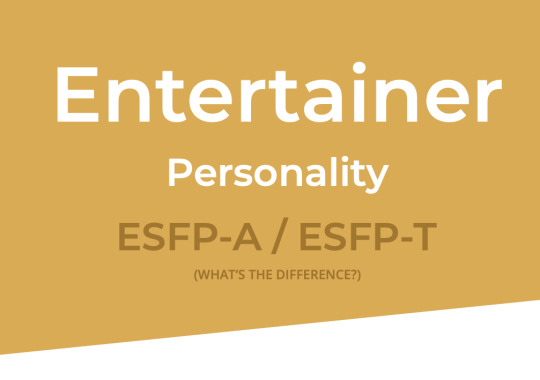
The Entertainer personality type gets “caught up in the excitement of the moment, and want everyone else to feel that way, too”. They are, allegedly, generous with their time and energy. I do feel like this describes my personality in some way. There both are strengths and weaknesses I agree with.
Seeing as we were asked to do this personality test after our discussion on employability skills, it was easy to see these personality traits in an employment capacity too.
One of the strengths of an entertainer is their people skills: “talkative, witty, and almost never run out of things to discuss”. People skills are very important in the workplace - even though I've never had a job in a creative field, interacting with people has always been important. As a swimming teacher your entire job is based around interacting with children and their parents, and your people skills dictate how you can do your job. This isn’t the case, necessarily, for a job in an art field, as lots of people’s careers take shape behind a screen and through social media, etc, but I still think they’re particularly important. I hope to have a job in a studio one day, and the image I have in my head is that of a group of people - a community, almost - working together to create something equally as important to all of them. People skills are vital for that kind of environment.
There are weaknesses, too, for the entertainer personality, that I think I share. These can be big weaknesses where employment is concerned: sensitivity, inability to long-term plan, inability to focus. Sensitivity can be a big issue for creatives, especially as your work can be very close to your heart and very personal. It can make one very vulnerable, especially to criticism, which is very common - and accepting constructive criticism and using it to grow is a vital part of progressing in the creative field.
16 Personalities discusses your personality type incredibly in depth, including your career path. They stress that entertainers belong in careers that surround them with people, and jobs where they are stuck behind a screen should be avoided. I’ve always thought I would prefer a creative job working with others, instead of working alone in a studio by myself and interacting with clients through social media or email. It’s interesting to see it detailed on the website.
Of course, for some people the Myers-Briggs test is a bit like astrology. It’s kind of made up, and because it details your personality, you’ll believe it. Some people enjoy being put in categories and some don't, but personally I find it interesting to see how I'm characterised compared to others. I don’t think it’s possible to characterise someone based entirely on something like this, but if anything, it’s fascinating to get a personality type based on a few questions and answers.
I’m also the same personality type as Marilyn Monroe, which is cool.

I know, unfortunately, very little about networking. It’s never come up in any course I’ve done before, art or otherwise, but would always have been extremely useful.
One of the best networks of people I’ve found so far for ‘networking’, feedback and support has been my coursemates. Whenever any of us have a question, everyone jumps to help. Although this isn't exactly networking I think it is an incredibly useful support system, and we often discuss and offer up opportunities we’ve found online.
Speaking of online - the best place for networking and finding other creatives is the internet. It’s ridiculously easy to find people to talk to that are in the same field, and also to find projects, competitions or collaborations to get involved in. The creative industry online is very good at creating challenges and competitions that millions of people can join in with, giving recognition and access to artists around the world.
Ideally, I would love to get back to posting on Instagram and online, and I’ve also given a lot of thought to posting videos on YouTube (I have a channel, although currently it only has a few travel videos) in order to get more feedback and start building a community of people I can engage with. I think for me, it would be foolish not to take advantage of the platforms I have access to - even if I have been a bit lax with posting in the past.
Personally I have found plenty of people online. I was even part of an engagement group for a while, where we hyped up one another's posts and posted feedback and encouragement, all with fellow creatives. It’s no longer active but was a great source to have, and even though it’s inactive, those are contacts I will have for life.
0 notes
Text
about me

I’ve been putting this one off. I struggled for a while to write this entry, which strikes me as funny, seeing as it’s all about me. You’d have thought I’d know the most about myself - and I do, of course, but I think the hard part is articulating it, or writing it down.
For starters I thought about what I'm like creatively. I have always loved drawing people, specifically girls, in fashionable clothes and outfits. Even as I got older, I still found myself defaulting to these when I needed something to draw. Often it was characters from already established films or projects: Disney princesses, superheroes, characters from musicals. For a long time I wanted to go into character design as I have always enjoyed developing characters of my own and making up backstories to go alongside them.
As I was growing up I think I had some kind of deprivation when it comes to films, specifically animated ones: I didn't watch anything Disney until I was about eleven, but after that I fell in love with them. As an adult I’ve educated myself on Studio Ghibli, programmes like Moomin, Over the Garden Wall, Avatar: The Last Airbender and Steven Universe. Although a lot of these programmes are for children, I’ve grown to appreciate what goes into making a show like it, how much care, attention and creativity it takes. I would love to be a part of something like that.

I bought an iPad Pro in January 2018 and fell in love with drawing on Procreate. Before then I’d loved watercolours and gouache, and although I took a brief break from using them whilst I got used to my iPad, I’ve always loved them. I know quite a lot about different materials; growing up I took it upon myself to try most of them, and I found which ones I liked and which ones I didn't. I started an Instagram to try and get my art out into the world and found a lovely community to encourage me.

Our first year module, Illustration Practice, helped me to experiment with different types of illustration. Although I wanted to do an illustration degree, I never actually knew much about the different aspects of it. I learned how to make gifs, learned of reportage, graphic novels, book publishing and children’s book illustration and editorials. I also gained more in-depth knowledge of character development and design. I loved this module a lot, and really appreciated how much it taught me, not to mention the friends I made.
There are parts of illustration that wouldn't necessarily work on this course that I would love to try. Like I mentioned, I've always loved fashion and fashion illustration, and I grew up doodling outfits in the back of my sketchbooks. I did textiles at high school and was not very good at sewing (admittedly, I never practiced all that much, but I've never been known for my patience). I had a long period of time where I didn't care about clothes or outfits, as many girls do - maybe some sort of teenage rebellion - but I’ve fallen back into it, and alongside it, the world of fashion illustration and photography. I think to explore it in an educational capacity I’d have to do a textiles degree instead, but of course there's no reason why I can’t explore it in my own time, like I always used to.
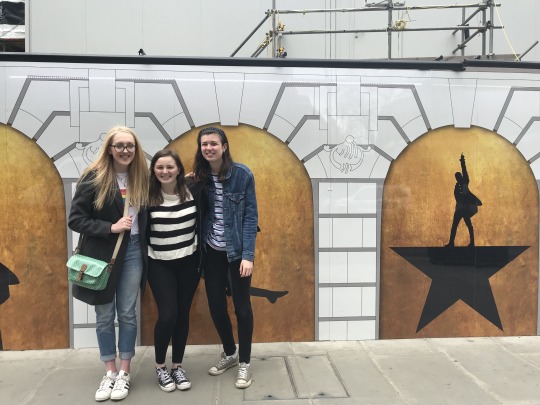
Tying into this, sort of, is musical theatre. For my fine art A Level I did a project on costume, and I focused on musical theatre, film and ballet, all three things I love. Musical theatre is one of my favourite things in lots of aspects; for a couple of years it was the only music I listened to, and I still love watching and listening to them dearly. A few of my friends are ‘musicals friends’, in that I only ever really see them to watch a show!
I suppose if you were to ask me to tell you what defines me, what thing I really love that I dedicate lots of my time and effort to, it would be swimming. It doesn't tie into my creative identity much, but it’s an outlet, and a hobby, one that has always helped me. I’ve been swimming all my life but started competitively when I was 10, joining a swimming club, and I've been training with them ever since. Now, as a senior, I train seven times a week - twice in the early morning - and surprisingly, I've never got bored. In fact swimming has always helped me cope with stress and anxiety: I kept training all through my exams and last year when I lived at uni and trained less with the uni team, I could really feel a difference in my mental health. Now I'm living at home and back up to seven sessions a week, I may be a bit more tired, but I'm happy.
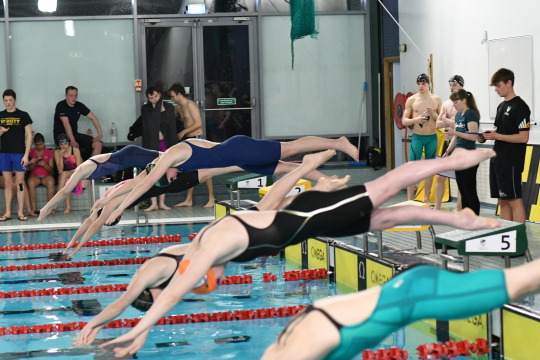
Like everyone, there's lots of random things that make me who I am. I’m a vegetarian and have been since I was about seven or eight (in reality it stemmed from me being a picky eater, so I can't say it was because of my steadfast morals, although it kind of is now). I love to read, even if I rarely have time any more. Now I take trains to uni I’m trying to get back into it. I am very, very, embarrassingly bad at maths. I have a bit of an obsession with pirates - I’m not sure whether it comes from the outfits, or the swashbuckling adventure, or the Pirates of the Caribbean franchise. I always wear proper pyjamas with collars and buttons, and I find it extremely bizarre that people can go to bed in any random clothes. Sleeping in joggers is morally wrong, in my opinion.
When I came to university my ideal career was working in visual development for films or television, to be part of a team making something I love to send out in the world for people to love and enjoy. It’s easy to see how attached people get to films they love, and it would mean the world to me to bring that enjoyment to someone. This would still be an ideal career for me, but university has taught me about different options in our field, ones I also have an interest in. I’m excited to explore these more.
Plus, it will be incredibly interesting, in ten years’ time, to come back to this - this blog entry on a public platform - to see what I loved, what interested me and what I wanted out of my career, and where I ended up.
0 notes